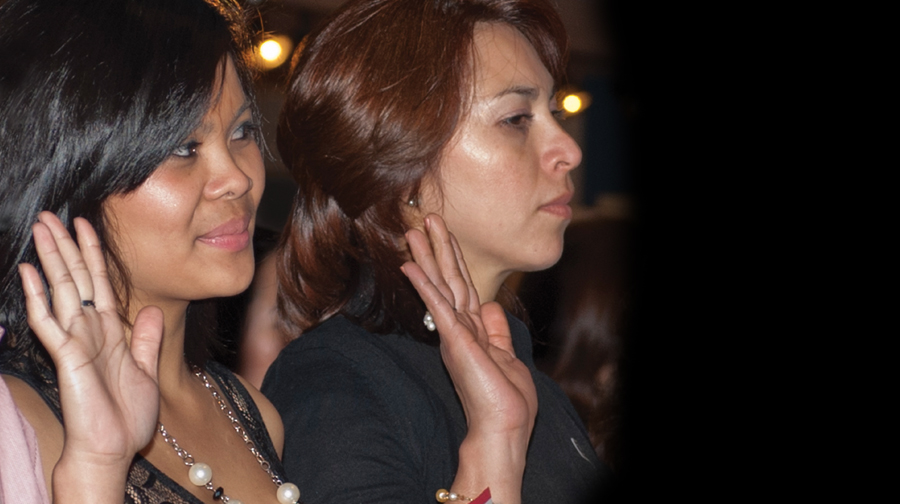

Inside the Dome Theater at The Institute of Texan Cultures, a doctor from Pakistan speaks eloquently about the American dream.
A shaft of light illuminates Irfan Agha within the shadows and stillness of the 360-degree-venue. Before him sit more than 200 men, women and children from 50 nations. Behind him, U.S. District Judge Xavier Rodriguez smiles proudly. Two colorful flags frame the moment. The naturalization ceremony is bathed in red, white and blue.
"Ladies and gentlemen," Agha said, "America is a unique country. It is a country where, in the words of William Ward, if you can imagine it, you can achieve it. If you can dream it, you can become it. Only in this country could the scion of a broken family, at times subsisting on food stamps, go to the best universities of the land because he was smart, and eventually rise to become the president because he was able.
"Nowhere else in the world is this possible, I guarantee you. This is still the land of hopes and dreams, and there is no other idea of a country like this, perhaps since the days of the Roman Republic."
On Feb. 23, Irfan, his wife Fauzia and their two children completed a remarkable journey. They became U.S. citizens almost 15 years after leaving Pakistan with belongings packed in suitcases and aspirations filling their hearts.
Each year, more than 2,000 people become naturalized citizens at the Institute of Texan Cultures (ITC), a museum on the UTSA HemisFair Park Campus. Eight times a year, the museum turns into a federal courthouse with petitioners taking an oath to defend the U.S. Constitution.
As a setting for this ceremony, the Institute of Texan Cultures serves logistical and symbolic purposes. The John H. Wood Jr. Federal Courthouse next door lacks the space to accommodate the event, which draws an average of 200 petitioners, plus hundreds of their relatives and friends.
The ITC also offers a rich showcase of ethnic history. The museum tells the story of settlers from Germany and Spain, Mexico and France, and celebrates the cultural diversity of Texans, whose ancestral roots reach around the world.
The cultures on exhibit in the ITC mirror the faces of the new Americans. At a February naturalization ceremony, the roll call of nations included Egypt, Iraq, Mexico, New Zealand, Canada and the Democratic Republic of Congo, as well as dozens more.
"We are a community partner," said JoAnn Andera, ITC director of special events. "When we do something like a naturalization ceremony, it brings home what our mission is. We are about people, and UTSA is definitely about people. UTSA is a leader within our community."
The ceremony is a moving symphony of patriotism. A junior ROTC color guard enters with the American and Texas flags. A military band from Fort Sam Houston plays John Philip Sousa’s Stars and Stripes Forever. A video shows images of broken and triumphant soldiers on 26 screens. The voice of the late John F. Kennedy intones, "Ask not what your country can do for you—ask what you can do for your country."
Judge Rodriguez leads the petitioners in an oath. A collective "I do" fills the Dome Theater. The judge congratulates the new U.S. citizens.
Amid the rain of applause there are smiles and tears. Each immigrant has come with a story, narratives that weave across nations to reach a single destination—a desire for citizenship. Claude Le Saux shared her journey with fellow petitioners. She left France in 1996 to complete post–doctoral-studies at the University of Hawaii. Le Saux never went back.
She moved to Texas and raised a family in San Antonio. A 16-year-old-daughter and a 12-year-old-son attend St. Mary’s Hall college preparatory school. Today, Le Saux is a professor of medicine and cardiology at the University of Texas Health Science Center. "After spending so many years here," she explained, "I wanted to become part of where I live."
Naturalization ceremonies at the ITC date to at least the early 1980s. Over the years, presiding judges have also administered the oath of citizenship in some unusual circumstances. Some immigrants became citizens on their deathbeds. In 1999, when U.S. Magistrate Judge John Primomo swore in 107-year-old-Mexican immigrant Ruperta Urresta Hernandez at a Fort Sam Houston-area-home, Hernandez became the oldest naturalized citizen in U.S. history.
Irfan Agha is only 44. Yet he felt the same pull toward naturalization as Hernandez had. As Lee Greenwood’s Proud to be an American played on overhead video screens, his eyes and those of many others lifted to watch a slideshow of photos.
The ceremony completed, Dr. Agha and the other brand-new-citizens left the auditorium to continue their pursuit of the American dream.
–K. Rodriguez